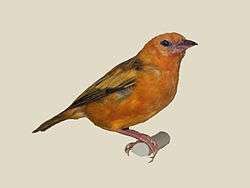Orange weaver
| Orange weaver | |
|---|---|
.jpg) | |
| P. aurantius subsp. aurantius in Ghana | |
| Scientific classification | |
| Kingdom: | Animalia |
| Phylum: | Chordata |
| Class: | Aves |
| Order: | Passeriformes |
| Family: | Ploceidae |
| Genus: | Ploceus |
| Species: | P. aurantius |
| Binomial name | |
| Ploceus aurantius (Vieillot, 1805) | |
| Synonyms | |
| |
The orange weaver (Ploceus aurantius) is a species of bird in the Ploceidae family.
Distribution
This species can be found in Angola, Cameroon, Central African Republic, Republic of the Congo, Democratic Republic of the Congo, Ivory Coast, Equatorial Guinea, Gabon, Ghana, Kenya, Liberia, Nigeria, Sierra Leone, Tanzania, Togo, and Uganda.[2]
Subspecies
- Ploceus aurantius aurantius (from Sierra Leone to Democratic Republic of the Congo, and south to Angola)[2]
- Ploceus aurantius rex (Uganda, Kenya and Tanzania)[2]
Habitat
The Orange Weaver live in mangroves, thickets and swamps in coastal lagoons and along major West African rivers.[2]
Description
Ploceus aurantius can reach a length of about 12.5 millimetres (0.49 in), including the tail.[3] These birds exhibit sexual dimorphism, and plumage also varies seasonally. During breeding or "nuptial" season, the male has a black beak, a small patch of black skin in front and behind the eyes (making the eyes look oval in shape), and brown wings. The rest of the plumage is a brilliant red to orange in color. Bill is pale and slender, while eyes are reddish-brown or pale grey.[2]
Outside of breeding season, the males sport plumage that is considerably more drab, brown overall with some dark streaks and a cream-colored belly. The females have the same plumage year-round, which resembles that of the off-season males. The males of this species are often confused with males of the species Euplectes orix, commonly known as the southern red bishop. This bird has a black belly, however.
Aviculture

The orange weaver is commonly kept in aviculture. They are quite hardy for small birds. Like all finches, they should be kept in groups. Because of their active nature, these finches should be housed in large aviaries. They may be housed with other, larger finches, and will generally do well in this situation. However, individual orange weavers can become quite aggressive during breeding season. Because of this, the aggressive finches must sometimes be separated from the group. Orange weavers should be fed a diet that is a balanced mixture of small cereal seeds, fresh greens and some live foods, such as meal worms. It can be noted by an orange weaver owner that orange weavers are able to enjoy Zupreem fruity pellets for Finches and will exhibit proper colorful plumage growth with each seasonal change.
Biology and behavior
In the wild orange weavers are polygamous, two or three females should generally be provided for each male and they make their homes in reed beds close to the surface of water. Like most other finches, these birds are colonial, with hundreds of complexly woven nests at some sites, which include palms, reeds and other trees.
They mainly feed on fruit and seeds, but also on insects (locusts, beetles, caterpillars). They arer usually found in pairs or in small groups. Males build an ovoid nest with grass and palm strips. Females lay two eggs and incubate them.[2]
References
- ↑ BirdLife International (2012). "Ploceus aurantius". IUCN Red List of Threatened Species. Version 2013.2. International Union for Conservation of Nature. Retrieved 26 November 2013.
- 1 2 3 4 5 6 Weaver Watch.
- ↑ Beauty of birds
